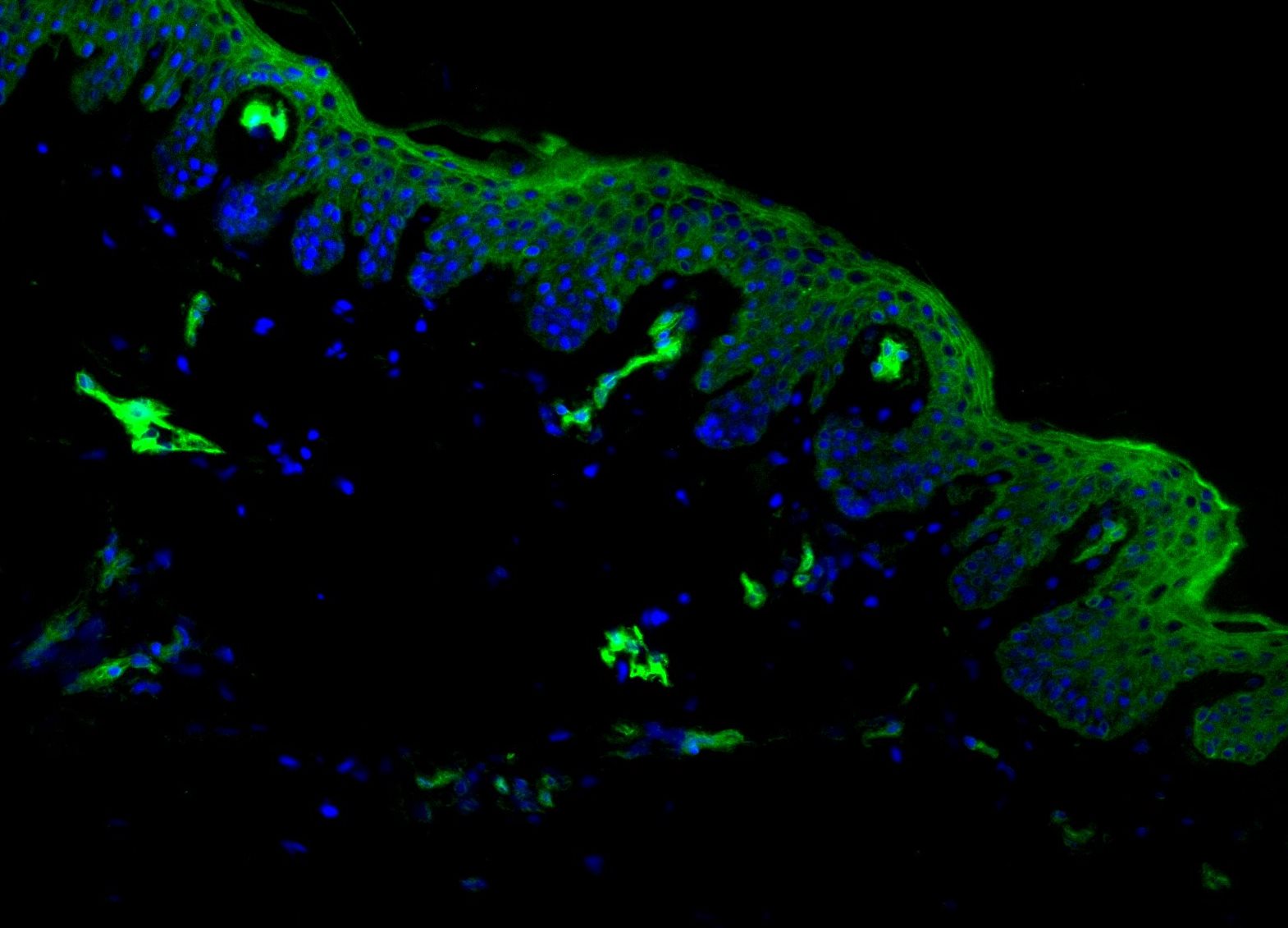Human ADAM10 Ectodomain Fluorescein-conjugated Antibody Summary
Thr214-Glu672
Accession # O14672
Applications
Please Note: Optimal dilutions should be determined by each laboratory for each application. General Protocols are available in the Technical Information section on our website.
Scientific Data
 View Larger
View Larger
Detection of ADAM10 in MCF‑7 Human Cell Line by Flow Cytometry. MCF-7 human breast cancer cell line was stained with Mouse Anti-Human ADAM10 Ectodomain Fluorescein-conjugated Monoclonal Antibody (Catalog # IC1427F, filled histogram) or isotype control antibody (Catalog # IC0041F, open histogram). To facilitate intracellular staining, cells were fixed with Flow Cytometry Fixation Buffer (Catalog # FC004) and permeabilized with Flow Cytometry Permeabilization/Wash Buffer I (Catalog # FC005). View our protocol for Staining Intracellular Molecules.
Reconstitution Calculator
Preparation and Storage
- 12 months from date of receipt, 2 to 8 °C as supplied.
Background: ADAM10
ADAM10 (also known as Kuzbanian, mammalian disintegrin metalloprotease, myelin-associated metalloproteinase) is a member of the ADAM family that contains a disintegrin and metalloprotease-like domain (1, 2). Like other membrane-anchored ADAMs, ADAM10 consists of the following domains, pro with a cysteine switch and furin cleavage sequence, catalytic with the zinc-binding site and Met-turn expected for reprolysins, disintegrin-like, cysteine-rich, EGF-like, transmembrane, and cytoplasmic. ADAM10 is highly conserved, with 97% amino acid identity between mouse, rat, bovine and human and 45% identity between mouse and Drosophila. The active enzyme processes notch, notch ligand delta, and amyloid protein precursor at the alpha site, playing an important role in neurogenesis (3, 4). It also processes the 26 kDa membrane-anchored pro-tumor necrosis factor-alpha (TNF-alpha ) to the 17 kDa mature TNF-alpha (5). It cleaves myelin basic protein and type IV collagen (6, 7). ADAM10 is widely expressed in tissues and resides both on the cell surface and in the cell (8, 9).
- Rooke, et al. (1996) Science 273:1227.
- Pan and Rubin (1997) Cell 90:271.
- Qi, et al. (1999) Science 283:91.
- Lammich, et al. (1999) Proc. Natl. Acad. Sci. USA 96:3922.
- Rosendahl, et al. (1997) J. Biol. Chem. 272:24588.
- Chantry, et al. (1989) J. Biol. Chem. 264:21603.
- Millichip, et al. (1998) Biochem. Biophys. Res. Comm. 245:594.
- Chantry and Glynn (1990) Biochem. J. 268:245.
- Fahrenholz, et al. (2000) Ann. N.Y. Acad. Sci. 920:215.
Product Datasheets
Citations for Human ADAM10 Ectodomain Fluorescein-conjugated Antibody
R&D Systems personnel manually curate a database that contains references using R&D Systems products. The data collected includes not only links to publications in PubMed, but also provides information about sample types, species, and experimental conditions.
2
Citations: Showing 1 - 2
Filter your results:
Filter by:
-
ADAM10-Interacting Tetraspanins Tspan5 and Tspan17 Regulate VE-Cadherin Expression and Promote T Lymphocyte Transmigration
Authors: JS Reyat, M Chimen, PJ Noy, J Szyroka, GE Rainger, MG Tomlinson
J. Immunol., 2017-06-09;0(0):.
Species: Human
Sample Types: Whole Cells
Applications: Flow Cytometry -
The impact of alpha-toxin on host cell plasma membrane permeability and cytokine expression during human blood infection by CA-MRSA USA300.
Authors: Nygaard T, Pallister K, Zurek O, Voyich J
J Leukoc Biol, 2013-09-11;94(5):971-9.
Species: Human
Sample Types: Whole Cells
Applications: Flow Cytometry
FAQs
No product specific FAQs exist for this product, however you may
View all Antibody FAQsReviews for Human ADAM10 Ectodomain Fluorescein-conjugated Antibody
Average Rating: 4 (Based on 1 Review)
Have you used Human ADAM10 Ectodomain Fluorescein-conjugated Antibody?
Submit a review and receive an Amazon gift card.
$25/€18/£15/$25CAN/¥75 Yuan/¥2500 Yen for a review with an image
$10/€7/£6/$10 CAD/¥70 Yuan/¥1110 Yen for a review without an image
Filter by:


